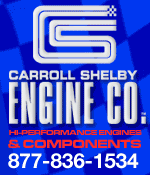
11-16-2006, 06:26 PM
|
 |
CC Member

|
|
|
Join Date: Jul 2004
Location: Alpharetta,
GA
Cobra Make, Engine: ERA #414 427 s/o w. Shelby Aluminum heads, Edelbrock Performer RPM Intake, Mighty Demon 750, Tremec TKO 600
Posts: 714
|
|

 Not Ranked
Not Ranked

Mike,
I think most people have told me that trying to pull a little vacum is a good thing and if you have too much intake, you arent' going to get that. Seems on the right side you need to have intake from either the filler tube or the valve cover, but not both. And the air is going to pull from path of least resistance. So if you have PCV in the rear, and breather on rear of right valve cover, you probably aren't going to get much pull from the left front valve cover breather. So seems if you put the PCV in the left front, then you'll get some pull from the right rear cover and rear center intake, or just cap off the intake vent and have the PCV in the right rear valve cover, with the left front being the intake and then you're getting flow from one corner to the other. Also, don't remember if you have solid lifter cam or hydraulic, but if it's hydraulic and you don't have a lifter valley pan, you'll be throwing a lot of oil up into that rear intake location which is going to cause oil to go somewhere depending on if it's a PCV or a breather there. At least it's an easy thing to play with vs having to tear something down to do it!
Scott

|

















 Hybrid Mode
Hybrid Mode


